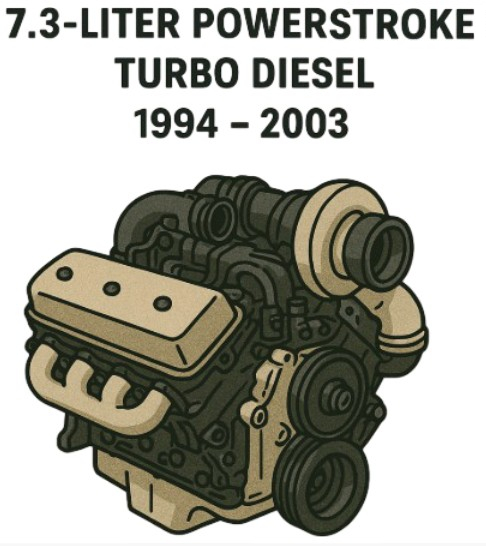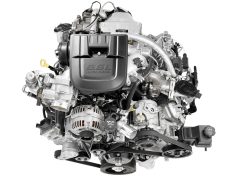%%date%% %%sep%% %%sitename%%
The beginning of the Powerstroke engine started in 1982. At the time, Ford Motor Company was looking for a way to turn its Super Duty pickups into something popular with the regular truck-buying crowd. This led Ford to strike up a partnership with International Truck and Engine Corporation, also known as ITEC, and later renamed Navistar.
Ford and ITEC worked together to create a new standard for diesel engines in passenger trucks. The result eventually helped redefine the industry. The first Powerstroke engine came out in 1988 as a 6.9-liter Indirect Injection engine. It only had 170 horsepower, but it was eagerly awaited. What followed was a 7.3-liter IDI diesel that was made between 1988 and 1993.
7.3-Liter Powerstroke Turbo Diesel: 1994 – 2003
7.3L Powerstroke
The first Powerstroke turbo diesel engine debuted in 1994. This was essentially the original 7.3-liter, but with the addition of direct injection and a turbocharger. Technically, this is also the first engine to use the Powerstroke name. The 7.3-liter Powerstroke turbo diesel featured a turbocharger with a wastegate, HUEI fuel injectors, and an intercooler. The engine was a huge hit with truck buyers, and they were produced nonstop through early 2003.
You can find the 7.3-liter Powerstroke in Ford F-250 and F-350 trucks beginning in the model year 1994. Eventually, it was put in almost every Ford truck, SUV, or van with a diesel engine. It saw gradual improvements in power throughout this time and ended up with 275 horsepower and 525 pound-feet of torque.
By the time production ended on this engine, the Powerstroke name was firmly cemented among truck buyers. Diesel Power Magazine named the 7.3-liter Powerstroke as one of the best diesel engines ever made. It was considered to be the pinnacle of diesel engine technology during its nine-year run.
6.0-Liter Powerstroke Turbo Diesel: 2003 – 2007
6.0L Powerstroke
The next generation of Powerstroke diesel was introduced in 2003. The 6.0-liter Powerstroke turbo diesel introduced some new features like a variable geometry turbocharger, an advanced fuel injection system, and the new exhaust gas recirculation system to meet emissions standards. The biggest change for this engine was the need to meet new emissions standards. Ford and International opted to build an all-new engine rather than modify the 7.3-liter Powerstroke.
The smaller size of the 6.0-liter engine gave it better fuel economy, but it also produced more power thanks to the advanced tech of a variable-geometry turbocharger and digital fuel injection. Ford put the 6.0-liter Powerstroke in F-Series trucks, E-Series vans, and some Ford Excursion SUVs, depending on the model year.
Looking back, many people wonder if this engine was good. In fact, it went through rigorous testing before going to market and was problem-free off the production line. However, its reliability and longevity strongly depended on whether the engine was modified or not. Problems cropped up when enthusiasts started adding power mods. At that point, some weaknesses became apparent, including issues with the head bolts, EGR cooler, oil cooler, turbocharger, and more.
6.4-Liter Powerstroke Twin Turbo: 2007 – 2010
6.4L Powerstroke
In 2007, the 6.4-liter Powerstroke debuted with twin turbochargers and high-pressure common rail fuel injection. The cutting-edge technology gave it an impressive 350 horsepower and 650 pound-feet of torque at only 2000 RPM. However, like the engine that came before it, the 6.4-liter Powerstroke was very short-lived. It was first put in Ford trucks for the 2008 model year, starting in 2007.
The 6.4-liter Powerstroke twin turbo was supposed to improve on the 6.0-liter Powerstroke and fix some of that engine’s issues. In some ways, it did do that with a better high-pressure fuel pump and strong OEM rods. However, it was plagued with issues like DPF clogging, oil cooler failure, a leaky radiator, and weak pistons. Like the 6.0-liter, the 6.4 had a strong foundation, provided it wasn’t modified. If it were modified, the problems would snowball, which has led many enthusiasts to simply replace as many problematic parts as possible.
The problems with both this engine and the previous engine brought about the end of the working relationship between Navistar and Ford. Ford would go on to design its next version of the Powerstroke diesel in-house, which turned out to be a good decision because the current 6.7-liter is still going strong after debuting in 2011.
6.7-Liter Modern Powerstroke: 2011 – Current
6.7L Powerstroke
The current Ford Powerstroke engine came out in 2011 as a 6.7-liter. It was all new and built from scratch rather than improving upon the previous engine. New features included fast-start glow plugs, aluminum cylinder heads, a compacted graphite iron engine block, and piston-cooling jets. The 6.7-liter is still going strong today with placement in Ford Super Duty and cab chassis trucks.
Why is the 6.7-liter doing so well? There are a few reasons. It offers excellent performance, and it’s proven to be quite durable with robust construction. Ford designed it to last with reliable performance throughout its lifespan over many miles. As mentioned above, the 6.7-liter’s success was the result of Ford deciding to design its next diesel engine in-house.
Some key features of this engine include its unique configuration, nicknamed “Scorpion” in the design house. It also includes an overhead valve design for superior durability and performance, and it’s noticeably quieter than previous Powerstroke engines. Over the years, the 6.7-liter Powerstroke has undergone several changes and enhancements, but it remains functionally the same engine. It initially made 390 horsepower but achieved up to 475 horsepower by 2021.
You can count on ProSource Diesel when you need replacement parts or aftermarket upgrades for your old or new Powerstroke diesel engine. We stock a quality selection of diesel parts, kits, accessories, and much more to keep your diesel truck running like new.
%%excerpt%%
The post Exploring the Powerstroke Generations Through the Years appeared first on Prosource Diesel.
%%category%%
%%tag%%







